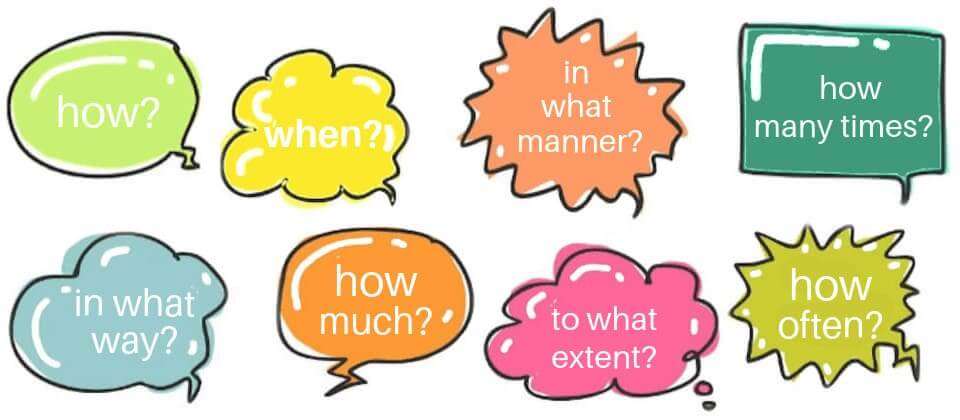Adverb Definition AND Types

An adverb is a word, or phrase, which modifies verbs, adjectives or other adverbs to describe how, where or when an action took place. Here we’ll look at adverb definition and types, with examples.
Many people find adverbs hard to understand or recognise in a piece of text.
Look for the words that answer questions such as:
– in what way?
– to what extent?
– how much?
– how often?
Examples
Jason talked loudly.
He speaks English fluently.
They shared the cake fairly.
She always shops online.
According to the adverb definition, an adverb is a word that modifies or describes a verb, adjective, or other adverb in terms of manner, frequency, degree, or place.
Example: “He quickly ran towards the finish line,” the adverb “quickly” modifies the verb “ran” by indicating the manner in which he performed the action.
HOW TO FORM ADVERBS
Adverbs are often formed by adding -ly to an adjective:
slow – slowly
weak – weakly
frequent – frequently
although there are many exceptions and irregulars, for example:
very
too
fast
TYPES OF ADVERBS
There are different kinds of adverbs.
Adverbs describe when, where, how, how often, how much an action took place.
Adverbs are divided into categories to reflect this.
There are five adverb types:
adverbs of time – when? for how long? how often?
adverbs of place – where?
adverbs of frequency – how often? how many times?
adverbs of manner – how? in what way? in what manner?
adverbs of degree – how much? to what extent?
1. ADVERBS OF TIME
Adverbs of time express when something happened:
today, yesterday, tomorrow, tonight, first, last
early, later, soon, regularly, never
These adverbs tell when and answer questions
– when?
– at what time?
– for how long?
– how often?
An adverb of time may be found at the beginning or end of a sentence, before or after the main verb.
Yesterday the sun shone and there was not a cloud in the sky.
He will come round later.
The position of the adverb of time at the beginning of the sentence puts emphasis on the time.
2. ADVERBS OF PLACE
Adverbs of place express where something happened:
here, there, nearby, inside, outside, underground,
overground, top, somewhere, nowhere
They answer the question
– where?
An adverb of place is almost always placed after the verb.
They are not used to modify adjectives or other adverbs.
John looked everywhere for his lost keys.
The boys were playing outside.
Note – many adverbs of place are also prepositions of place – when used as prepositions they are followed by a noun.
3. ADVERBS OF FREQUENCY
Adverbs of frequency express how often or how many times something happened:
frequently, infrequently, regularly, often, always, daily,
weekly, fortnightly, again and again, enough, only
They answer the questions
– how often?
– how many times?
An adverb of frequency is mostly placed before the verb.
He rarely visits his mother.
She always forgets her books.
exceptions are the more specific adverbs daily, fortnightly, yearly, annually
The menu changes daily.
Adverbs of frequency express degrees of frequency.
4. ADVERBS OF MANNER
Adverbs of manner express how something was done
cheerfully, sadly, slowly, wearily, firmly, foolishly,
delightfully, carelessly, selflessly, kindly, hastily
Most adverbs of manner end in -ly
some exceptions include well, hard, late, fast
They answer the questions
– how?
– in what manner?
The girl read quickly.
The boy ate hungrily.
If there is a direct object in the sentence, the adverb of manner comes after it, and not straight after the verb:
The child petted her dog lovingly.
The artist painted the model beautifully.
5. ADVERBS OF DEGREE
Adverbs of degree express how much something is done. They express the intensity.
extremely, fully, hardly, somewhat, thoroughly, very,
fairly, really, nearly, barely, too, just, enough
They answer the questions
– how much?
– to what extent?
– to what degree?
An adverb of manner will often come before the word they are modifying.
The exam was extremely easy.
It was barely raining.
It was very interesting to live in Japan for a year.
HOW TO USE ADVERBS
with verbs
in many cases they can come before or after the verb. If they come before the verb they generally add more emphasis:
He ate his lunch quickly.
He quickly ate his lunch.
with adjectives
they often make the adjective stronger or weaker.
She was hugely overweight
She is very tall.
with other adverbs
they change the degree of intensity
He ran too slowly.
She was talking very quickly.
PRACTICE EXERCISES
1. Adverbs of time answer all of these questions, except
a. when
b. for how long
c. why
d. how often
2. Adverbs can modify all of the following, except
a. verbs
b. adjectives
c. other adverbs
d. conjunctions
3. Make the following into adverbs
slow
lucky
fast
economic
early
Answers
1. c 2. d
3. slowly, luckily, fast, economically, early